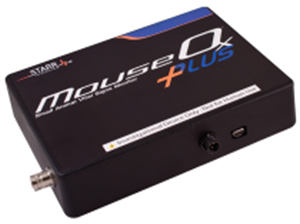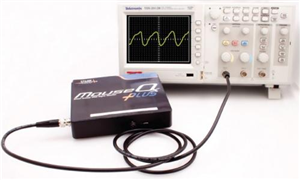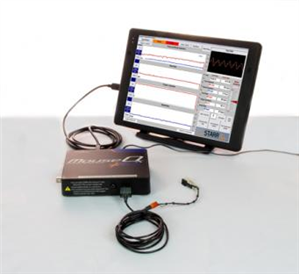

015001
MouseOxPlus® 230V
- Overview
- Specifications
- Accessories
- Citations
- Related Products
Overview



There are 3 images available to view - click to enlarge and scroll through the product gallery.
Mouseox Plus manual
/ Download as PDF
The MouseOx® Plus pulse oximeter is the world's first and only patented noninvasive vital signs monitor for small laboratory animals. It is used for vital sign monitoring or data collection of heart rate, arterial blood saturation, breath rate and more in mice, rats, and other small animals.
- Non Invasive
- Used with:
Anesthetized and conscious subjects
Animal sizes from neonates mice through adult rats
Mice, rats, and other small laboratory animals with pulse rate from 90-900 BPM such as marmosets, rabbits, guinea pigs, hamsters, voles, tree shrews, ferrets, opossum, rabbits
- MRI compatible sensor available (see MouseOx Plus sensors)
- Monitor up to 16 subjects with one MouseOx Plus (see Multiplexer)
- Analogue output of pulse waveform
Provides the following measurements:
- Arterial Oxygen Saturation
- Heart Rate
- Breath Rate
- Temperature*
- Pulse Distention
- Breath Distention
- Activity (Optional)
Frequently Asked Questions
Q: What is the difference between the MouseOx® and MouseOx Plus®?
A: The MouseOx Plus® pulse oximeter uses the same pulse oximetry technology as the original MouseOx® but also includes several significant improvements. The MouseOx Plus® has enhanced signal processing ability that improves response to the motion of conscious mice, rats, and other small laboratory subjects. The pulse signal is maintained during more significant movement and the SpO2 signal is re-acquired more quickly following significant movement. The MouseOx Plus® has a modular software design that allows the end user to purchase only the functionality that is needed. Measurement of core body temperature is now available with the MouseOx Plus®. The MouseOx Plus® can be used in conjunction with our multiplexers in order to monitor up to 8 animals with temperature, or 16 animals without temperature, using 1 MouseOx Plus.
Q: Will the MouseOx®/MouseOx Plus® work with both mice and rats?
A:Yes. There are 16 variations of the MouseOx® sensor available to accommodate various sensor placement options on mice and rats weighing from 1 to 500+ grams.
Q: What is the size range of mice and rats that can be used with the MouseOx®/MouseOx Plus®?
A: The MouseOx® works on mice and rats and other small laboratory animals ranging in size from neonatal mice to rats over 500gm. The subject must have a heart rate of at least 90 BPM and no greater than 900 BPM.
Q: Does the MouseOx®/MouseOx Plus® work on animals other than mice and rats?
A: The MouseOx® is being used in many research projects on subjects other than mice and rats. Some examples include tree shrews, voles, Guinea pigs, hamsters, rabbits and small primates such as marmosets. (Note: The MouseOx® oxygen saturation measurement has only been validated with mice and rats.)
Q: Will the MouseOx®/MouseOx Plus® work on subjects with non-white fur?
A: Yes, the MouseOx® works on subjects with all colors of fur. The sensor location may need to be shaved on animals with dark fur. The MouseOx® may have difficulty obtaining measurements on subjects with very darkly pigmented skin.
Q: Does the MouseOx®/MouseOx Plus® need to be connected to any other equipment in order to function?
A: The MouseOx® must be connected to a Windows computer with a USB 2.0 port and running the latest version of the MouseOx® software. MouseOx® also requires wall outlet power.
Q: Can I run MouseOx®/MouseOx Plus® on an Apple/Mac computer?
A: Yes, with the use of a Windows® emulator such as Parallels Desktop©.
Q: How does the MouseOx®/MouseOx Plus® calculate arterial oxygen saturation?
A: The MouseOx®, like all pulse oximeters, directly measures the absorption of light by hemoglobin, which varies depending on the degree to which oxygen is bound to hemoglobin. Since 97% of oxygen is carried to the tissues by hemoglobin, arterial oxygen saturation is a very good indicator of cardio-pulmonary status.(Note: pulseoximetry does not measure PaO2)
Q: How often do I need to calibrate the MouseOx®/MouseOx Plus®?
A: The MouseOx® has been calibrated at the factory, and does not require any further calibration. Calibration data is contained within the software so you must not use a software revision earlier than that which was supplied at the time of purchase.
Q: What is the expected range of oxygen saturation for anesthetized and awake mice?
A: Normal saturation for mice and rats should be in the range of 95-97%. This range should be the same for both anesthetized and awake animals as long as anesthesia is administered properly. Awake animals at rest may have oxygen saturation as low as 90% for various reasons such as huddling in a corner of their habitat which can cause re-breathing.
Q: How many subjects can the MouseOx®/MouseOx Plus® monitor at a time?
A: The MouseOx® is limited to monitoring/recording one subject at a time. The Multiplexer for the MouseOx Plus® enables you to monitor up to 16 subjects, one at a time, with only one MouseOx Plus®.
Q: Has the MouseOx®/MouseOx Plus® ever been used in any studies that have been published?
A: Yes, the MouseOx® has been referenced in hundreds of peer-reviewed publications. See the Citations tab.
Q: What are Pulse Distention and Breath Distention?
A: Pulse Distention is a measure of the change in volume of the blood vessels in the sensor light path due to local blood pressure changes induced by the beating of the heart. Breath Distention is a measure of the change in volume of the blood vessels in the sensor light path due to local blood pressure changes induced by the change of intrathoracic pressure associated with breathing.
Q: How does the MouseOx®/MouseOx Plus® obtain the respiratory rate from the sensor?
A: The MouseOx is sensitive enough to measure the blood volume variations in the sensor light path due to variations of intrathoracic pressure. From this measurement we can determine both breath distension and breath rate.
Q: What is the purpose of the analogue output on the MouseOx Plus®?
A: An analog pulsatile waveform generated from the raw infrared light signal is output to the BNC connection on the outside of the MouseOx Plus enclosure. This signal can be monitored and recorded for further analysis or used in gating applications.
Specifications
Accessories
015020
XS CollarClip™ w/ Blank Clip: Conscious Unshaved Mouse 1-15 gm, Shaved Mouse 1-20 gm
015027
S ThroatClip™: Anesthetized Unshaved Mouse > 15 gm, All Mice > 20 gm, Rat 5-30 gm
015021
S CollarClip™ w/ Blank Clip: Conscious Unshaved Mouse > 15 gm, All Mice > 20 gm, Rat 5-...
Citations
Chintamaneni, K., Bruder, E., & Raff, H. (2014). Programming of the Hypothalamic-Pituitary-Adrenal Axis by Neonatal Intermittent Hypoxia: Effects on Adult Male ACTH and Corticosterone Responses Are Stress. Endocrinology. Retrieved from https://press.endocrine.org/doi/abs/10.1210/en.2013-1736
Deng, J., & Zhang, J. (2014). Critical role of matrix metalloprotease-9 in chronic high fat diet-induced cerebral vascular remodelling and increase of ischaemic brain injury in mice. Cardiovascular …. Retrieved from https://cardiovascres.oxfordjournals.org/content/103/4/473.short
Duehrkop, C., & Rieben, R. (2014). Refinement of tourniquet-induced peripheral ischemia/reperfusion injury in rats: comparison of 2 h vs 24 h reperfusion. Laboratory animals. Retrieved from https://lan.sagepub.com/content/48/2/143.short
Houin, P., & Veress, L. (2014). Intratracheal heparin improves plastic bronchitis due to sulfur mustard analog. Pediatric …. Retrieved from https://onlinelibrary.wiley.com/doi/10.1002/ppul.23043/full
Kao, Y., Li, W., Lai, H., & Oyarzabal, E. (2014). Dynamic Perfusion and Diffusion MRI of Cortical Spreading Depolarization in Photothrombotic Ischemia. Neurobiology of …. Retrieved from https://www.sciencedirect.com/science/article/pii/S0969996114001995
Lax, S., & Wilson, M. (2014). Using a non-invasive assessment of lung injury in a murine model of acute lung injury. BMJ Open Respiratory …. Retrieved from https://bmjopenrespres.bmj.com/content/1/1/e000014.abstract
Ono, M., & Oliver, D. (2014a). Asymmetric temporal interactions of sound-evoked excitatory and inhibitory inputs in the mouse auditory midbrain. The Journal of physiology. Retrieved from https://jp.physoc.org/content/592/16/3647.short
Ono, M., & Oliver, D. (2014b). The Balance of Excitatory and Inhibitory Synaptic Inputs for Coding Sound Location. The Journal of Neuroscience. Retrieved from https://www.jneurosci.org/content/34/10/3779.short
Schaible, E. (2014). 2-Methoxyestradiol confers neuroprotection and inhibits a maladaptive HIF-1α response after traumatic brain injury in mice. Journal of …. Retrieved from https://onlinelibrary.wiley.com/doi/10.1111/jnc.12708/full
Torres, M., Laguna-Barraza, R., & Dalmases, M. (n.d.). MALE FERTILITY IS REDUCED BY CHRONIC INTERMITTENT HYPOXIA MIMICKING SLEEP APNEA IN MICE. journalsleep.org. Retrieved from https://www.journalsleep.org/AcceptedPapers/SP-031-14.pdf
Wang, Z., Huang, W., & Zuo, Z. (2014). Perioperative aspirin improves neurological outcome after focal brain ischemia possibly via inhibition of Notch 1 in rat. Journal of neuroinflammation. Retrieved from https://www.biomedcentral.com/content/pdf/1742-2094-11-56.pdf
Weaver, J., Yang, Y., & Purvis, R. (2014). < i> In vivoevidence of methamphetamine induced attenuation of brain tissue oxygenation as measured by EPR oximetry. Toxicology and applied …. Retrieved from https://www.sciencedirect.com/science/article/pii/S0041008X14000027
Yin, J., Li, H., Feng, C., & Zuo, Z. (2014). Inhibition of Brain Ischemia-Caused Notch Activation in Microglia May Contribute to Isoflurane Postconditioning-Induced Neuroprotection in Male Rats. CNS & Neurological Disorders- …. Retrieved from https://www.ingentaconnect.com/content/ben/cnsnddt/2014/00000013/00000004/art00020
Younce, J., Albaugh, D., & Shih, Y. (2014). Deep Brain Stimulation with Simultaneous fMRI in Rodents. JoVE (Journal of Visualized …. Retrieved from https://www.jove.com/video/51271/deep-brain-stimulation-with-simultaneous-fmri-in-rodents
Zhao, L., Abe, K., & Rajoria, S. (2014). Spatial light modulator based active wide-field illumination for ex vivo and in vivo quantitative NIR FRET imaging. Biomedical optics …. Retrieved from https://www.opticsinfobase.org/abstract.cfm?uri=boe-5-3-944
Zhao, M., Ma, H., Harris, S., & Schwartz, T. (2014). Multi-Spectral Imaging of Blood Volume, Metabolism, Oximetry, and Light Scattering. Neurovascular Coupling Methods. Retrieved from https://link.springer.com/protocol/10.1007/978-1-4939-0724-3_10



















Request
Catalogue
Chat
Print